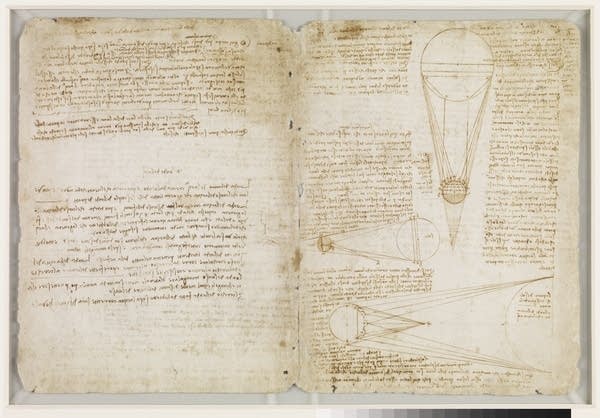New Mpls. Institute of Arts exhibit puts you inside da Vinci's head

Go Deeper.
Create an account or log in to save stories.
Like this?
Thanks for liking this story! We have added it to a list of your favorite stories.
Leonardo da Vinci is considered one of the most talented people to have ever lived.
The painter of the "Mona Lisa" and "The Last Supper" was also an engineer, an architect and an inventor.
This month, the Minneapolis Institute of Arts opened an exhibition of one of da Vinci's original notebooks, the "Codex Leicester," which offers a window into the Renaissance man's creative genius.
Turn Up Your Support
MPR News helps you turn down the noise and build shared understanding. Turn up your support for this public resource and keep trusted journalism accessible to all.
What exactly is the Codex Leicester?
A codex is just an old name for a bound manuscript. Over his lifetime, da Vinci wrote many manuscripts filled with his observations on everything from human anatomy to the flight patterns of birds.
The Codex Leicester is so named because it was purchased by the Earl of Leicester back in 1717. This journal is concerned with water, from how droplets form on leaves to whether or not there's water on the surface of the moon.
Da Vinci lived in the late fifteenth and early sixteenth centuries, at a time when the construction of canals and breakthroughs in hydraulic engineering were of great importance to civic life.
This show really presents people with an opportunity to see how da Vinci's mind worked, but it might be hard to navigate.
The pages of the codex are all written in Italian. Also, da Vinci wrote backwards, from right to left — because he was left-handed, and he found it easier to keep from smudging his writing and getting ink on his shirt sleeve this way.
The exhibition, however, comes with a "Codascope," an interactive screen that translates and explains the 72-page text of the Codex Leicester. And the pages are covered in lovely sketches da Vinci created to illustrate his ideas.
What do we know about Leonardo da Vinci?
According to the show's curator Alex Bortolot, da Vinci was a charming character. In addition to being incredibly curious about the world, he was also quite funny, and delighted in playing pranks on friends.
He was known for keeping a "pet dragon" which was actually a lizard to which he'd attached a pair of bat's wings. He loved animals and was a vegetarian before that was really even a thing. He was also a pacifist.
He came from humble beginnings. He was born out of wedlock and never got a formal university training. Bortolot says it may have been that da Vinci's lack of education was the ace up his sleeve.
"He was not conditioned to see the world in the ways that were in line with the prevailing scientific wisdom of the day," Bortolot said.
"That kind of unvarnished look at the world, feeling no allegiance to a kind of conventional wisdom, really allowed him to push through with his studies of the world revealing fascinating things," he added.
Da Vinci was really the father of the scientific method — he developed theories based on his observations of the world, and then he devised experiments to test his theories. If they failed, he'd revise his thinking and move on. And he was bold enough to question the prevailing thinking of his age.
What can we learn from da Vinci today almost 500 years later?
Bortolot says he finds this show particularly relevant, because as humanity faces complex problems of its own creation — the degradation of the environment and overpopulation, for example — our creativity will be our best resource for coming up with solutions to these issues.
Bortolot also warns that while da Vinci was an amazing man, we should be careful to not put him on a pedestal.
"Because creativity is timeless and universal it's something that we all have in us and I think one of the goals of the show is really to show people that the things that Leonardo did are things we do too, and all of us have the potential to make the world a better place, to change our lives," Bortolot said.
In recognition of that, the Codex Leicester has been paired with examples of work by contemporary innovators and thinkers.
If you go
Leonardo da Vinci, the Codex Leicester & the Creative Mind
Where: Minneapolis Institute of Arts, 2400 Third Avenue South, Minneapolis.
When: June 21 to Aug. 30


